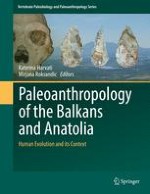2016 | OriginalPaper | Chapter
4. The Human Fossil Record from Romania: Early Upper Paleolithic European Mandibles and Neanderthal Admixture
Authors : Katerina Harvati, Mirjana Roksandic
Published in: Paleoanthropology of the Balkans and Anatolia
Publisher: Springer Netherlands
Activate our intelligent search to find suitable subject content or patents.
Select sections of text to find matching patents with Artificial Intelligence. powered by
Select sections of text to find additional relevant content using AI-assisted search. powered by
